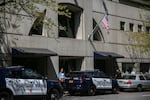Black people in Portland were dramatically more likely to be stopped by police in 2019 than their non-Black counterparts, according to data recently released by the Portland Police Bureau.
Of the 33,035 vehicle stops Portland police made in 2019, 18% were for Black drivers and 65% were for white drivers. Meanwhile, white people make up 75.1% of the population, while Black people make up only 5.8%.
The discrepancy is even greater for nonmoving violation stops, a category for which the report says officers have more room for discretionary judgement. Black people accounted for 22.6% of those stops compared to 62% for white people.
“It’s a very difficult situation to explain because the numbers are the numbers,” said Police Chief Chuck Lovell, adding this year’s data reflects an improvement in many ways. “But there’s a context to those numbers too that I think is worthwhile to understand.”
Lovell said that this is the first year African Americans were not stopped at a disparate rate, a calculation based on a “disparity index” the bureau uses to estimate expected values.

File photo from April 26, 2018 of the Portland Police Bureau
Abigail Winn / OPB
Rather than relying simply on census data, the bureau uses a complicated set of benchmarks to determine what outcomes they would expect to see in their stop data. The traffic division uses the demographics of people involved in injury-collisions, while the patrol division bases their benchmark on crime victimization data.
“Victim demographics are a reasonable description of general area characteristics, including the personal characteristics of individuals in the area,” the report reads.
The police bureau’s methodology might have some merit if there were a large Black population that commuted into Portland everyday, changing the city’s demographics for certain hours of the day, according to Elliott Young, a professor at Lewis & Clark College and the co-chair of the Portland Committee on Community-Engaged Policing.
“What does crime victimization data have to do with the number of drivers in the community?” asked Young. “(PPB) are simply fishing for benchmarks to justify disproportionate policing of Black people.”
It is revealing, Young said, that when it comes to explaining their pedestrian stop data, the bureau doesn’t rely on the same benchmarks. The bureau stopped 178 Black pedestrians in 2019, 16% of the total pedestrians stopped that year.
“So then they just say, ‘Oh, well, we know that Black people use public transportation and walk around a lot more,” Young said.
Overall, police stops increased in 2019. Vehicle stops increased 12% and pedestrian stops went up by 95%, a dramatic increase Lovell attributed to a new walking beat started at Central Precinct.
Related: In America’s whitest city, Black activists struggle to separate themselves from anarchists
Those stops frequently lead to searches, whether voluntary or based on probable cause. Officers requested to search just over 4% of all the drivers they pulled over in 2019. Broken down by race, officers requested to search 8.2% of the Black drivers who were pulled over and only 3.1% of the white drivers. The only other racial or ethnic category that was higher than the overall total was “American Indian/Alaskan,” who officers asked to search 5.8% of the time.
Black drivers consented to those searches at a dramatically higher rate than white drivers, a result the report links “an equity imbalance that can be traced back to systemic issues of race and power in the criminal justice system and law enforcement.”
Officers were more likely to find contraband on white drivers than on Black drivers, despite the higher search rate.
The report says “the average patrol officer uses discretionary traffic stops to contact potential subjects of interest and investigate crimes in addition to reducing injury collisions.”
Stopping people officers suspect of committing crimes is often where bias is introduced.
“And guess who they are likely to suspect? Black people,” Young said. “The hit rate on actually finding contraband is much lower for Black people than whites, so these policies end up just over-policing and under-protecting communities of color.”
He said if the city instead sent officers to the Lewis & Clark campus and started searching students, they would likely find numerous violations of the law.
“Policing basically will produce crimes,” Young said.
In response to the report’s findings, the bureau said it is changing the data it collects in order to make better decisions in the future.
“We wanted to make sure we were collecting the right and appropriate data to help us make informed decisions around stops and searches,” Lovell said.
The bureau will start audio recording consent searches so they can ensure people are being provided consistent information and an ability to better track those searches. The bureau also put out an instructional video to officers about searches and recording the necessary data.
Taken in its entirety, Young said the report paints a picture of a police bureau and a community that is moving in the wrong direction.
“Blanket over policing of people leads ultimately to mass incarceration,” he said. “And I think that’s something that we should be moving away from by stopping indiscriminate stops of both pedestrians and of people in cars.”
Correction: This story previously misstated the percentage of Portland’s population who identify as Black. OPB regrets the error.
